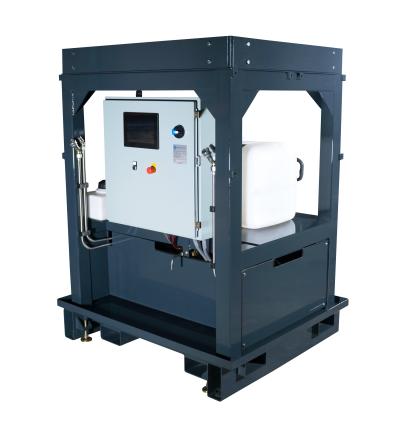
Unattended and lights-out production are only possible if all aspects of the process are self-sufficient, including maintaining coolant levels and concentration. Combining products from LNS North America and 168 Manufacturing ensures that coolant levels are automatically maintained, and that clean coolant is recycled from the chip hopper to reduce both coolant and labor costs.
The FullShopTM Automated Coolant Management System from 168 Manufacturing automatically manages coolant levels and concentrations by sensing and pumping properly mixed coolant to as many as 120 CNC machines. Meanwhile, the LNS Venturi Pump continuously removes and filters coolant from the chip hopper and returns it to the machine sump, thus eliminating cross contamination from central recycling.
Combining these two systems significantly reduces coolant usage, eliminates the need to manually top off coolant, and increases chip hopper volume by removing residual coolant. As a result, removing chips from the hopper is quicker, cleaner and easier.
Data from production at 168 Manufacturing’s parent company Precision Tool Technologies, Inc. on a universal turning machine equipped with both products indicate annualized savings of over 200 gallons of coolant is possible.
Contact Details
Related Glossary Terms
- computer numerical control ( CNC)
computer numerical control ( CNC)
Microprocessor-based controller dedicated to a machine tool that permits the creation or modification of parts. Programmed numerical control activates the machine’s servos and spindle drives and controls the various machining operations. See DNC, direct numerical control; NC, numerical control.
- coolant
coolant
Fluid that reduces temperature buildup at the tool/workpiece interface during machining. Normally takes the form of a liquid such as soluble or chemical mixtures (semisynthetic, synthetic) but can be pressurized air or other gas. Because of water’s ability to absorb great quantities of heat, it is widely used as a coolant and vehicle for various cutting compounds, with the water-to-compound ratio varying with the machining task. See cutting fluid; semisynthetic cutting fluid; soluble-oil cutting fluid; synthetic cutting fluid.
- turning
turning
Workpiece is held in a chuck, mounted on a face plate or secured between centers and rotated while a cutting tool, normally a single-point tool, is fed into it along its periphery or across its end or face. Takes the form of straight turning (cutting along the periphery of the workpiece); taper turning (creating a taper); step turning (turning different-size diameters on the same work); chamfering (beveling an edge or shoulder); facing (cutting on an end); turning threads (usually external but can be internal); roughing (high-volume metal removal); and finishing (final light cuts). Performed on lathes, turning centers, chucking machines, automatic screw machines and similar machines.
- turning machine
turning machine
Any machine that rotates a workpiece while feeding a cutting tool into it. See lathe.
